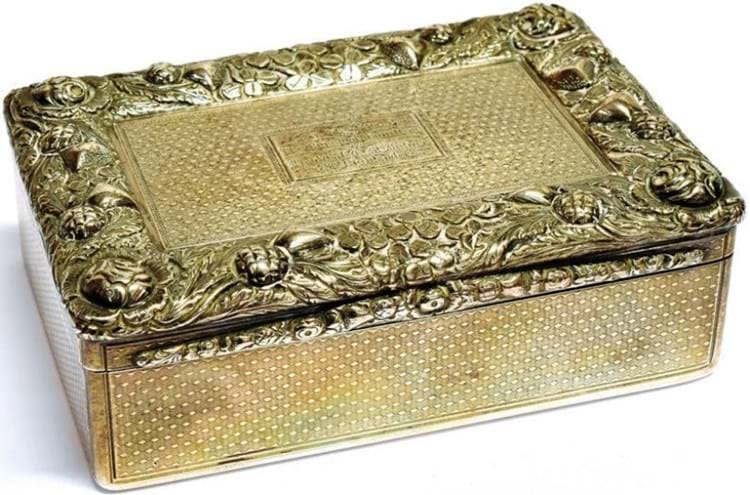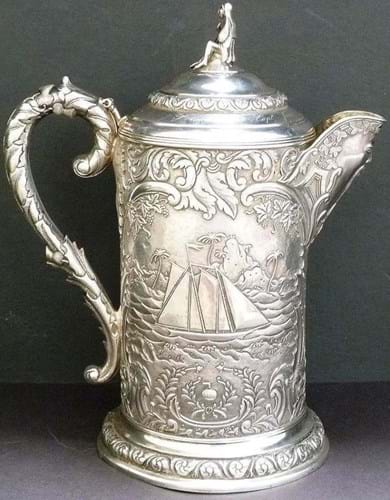
Mutiny marks make difference
Although this 10oz table snuff box is hallmarked for John Linnit, London 1824, much of its commercial value lies in the inscription.
Alongside a border of roses, thistles, shamrocks and leaves is a central panel to the lid reading: The Freedom of the Burgh of Hamilton to Lieu’t Col. C.McIntyre, 78th Highlanders. The gilt-washed interior adds: In honour of the Distinguished Services of Himself and the other Officers and Men of that Gallant Regiment during the Indian Rebellion of 1857 Hamilton, 22nd June 1860.
The connection to the Indian Mutiny (the corners further engraved Cawnpore and Lucknow) helped it to £3000 (estimate £500-800) at Greenslade Taylor Hunt (19.5% buyer’s premium) in Taunton on July 3.
Tea service from the Savorys

This 19th century tea service dated London 1880 and 1881 by the Savory makers sold for £6000 at Jacobs & Hunt.
Standard 19th century tea services often sell at much more than melt value but this 227oz example offered at Jacob & Hunt (22% buyer’s premium) in Liss on July 19 reflected the Aesthetic fashion.
Dated London 1880 and 1881, it was marked Goldsmiths Alliance Ltd, Cornhill, London and bore the initials of the four makers, Joseph, Albert, Horace and Ethelbert Savory, descendants of Adey Savory whose family firm became the Goldsmiths Alliance in 1866. Pitched at £6000-8000, it sold on the lower figure of £6000.
Some pieces of classic Georgian tableware went considerably above what were more modest expectations. A George Methuen (London 1757) two-handled soup tureen, 16½in (42cm) long, with a pomegranate finial to the cover, took £4800. A pair of smaller tureens, each 8½in (22cm) long, by John Henry and Charles Lias (London 1783), tripled expectations at £3200.
Flagon with Scottish touch
Chinese export silver is split into two time periods. From 1750- 1840 a system of small workshops in Shanghai manufactured silver pieces which were exact replicas of English silver. During the second phase, 1850-1920, the new generation incorporated Chinese motifs, such as chrysanthemums and dragons, into their work.
Something of a hybrid is this 8¼in (21cm) silver flagon. It was pitched at £800-1200 at the July 31 sale at the Carlisle rooms of Thomson Roddick (17.5% buyer’s premium). The flagon could be reasonably dated to c.1854 – the year its recipient, Captain James B Endicott, left his job as commander of receiving ships for Russell & Co, Macoa (sic) to join Thomas Hunt & Co.
He was presumably a Scotsman: as well as a chased merchant ship in full sail were flowering thistles and a curling stone. Marked for Khe Cheong, Canton, it sold in good condition to a buyer using thesaleroom.com at £6600.
Ingenious design

Matthew Barton of Olympia Auctions in west London sold this silver and enamel compact in the form of a stylised Alfa Romeo 6C for £3500.
It was back on May 22 when Matthew Barton (25% buyer’s premium) of Olympia Auctions in west London sold this silver and enamel compact in the form of a stylised Alfa Romeo 6C with James Young drophead coupé coachwork.
Probably Italian, it has London import marks for c.1929. The Art Deco design is ingenious. The wheels hinge to reveal powder or rouge compartments, the window cabin conceals a lipstick, the body springs open with a mirrored lid while to the rear is a ‘spare tyre clamp’ that unscrews to access the scent reservoir.
Production of Alfa Romeo’s 6C series started in 1927 with the car winning every major race it entered in 1929 including the grands prix of Belgium, Spain, Tunis and Monza as well as the Mille Miglia, the Brooklands Double Twelve and the Ulster TT. This compact, sold at £3500, may well have been made as a promotional object for the company.















